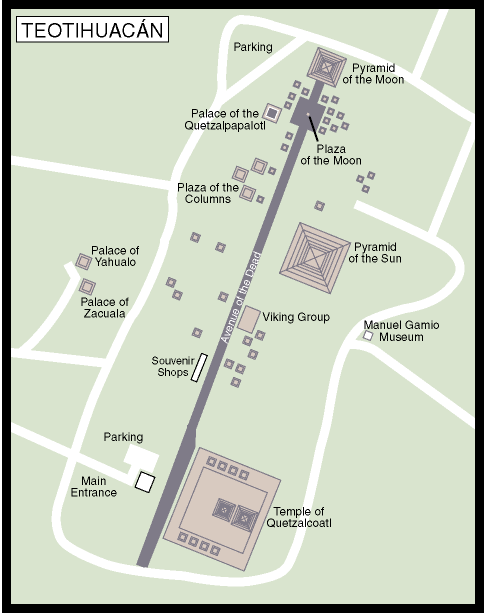WHI-Chap6/21-Teotihuacan
Teotihuacan was the earliest city of the human population around Lake Texcoco. The lake served not only as a food and water source, but also as a source of transportation to all of the communities on it's shore. Like many other societies in Mesoamerica, the cultural foundations of Teotihuacan were akin to those of the Olmecs. They adapted their calendar, even played the ball game popular with the Olmecs, and expanded on their writing system. However, all of their books have perished.
Teotihuacan was a large agricultural center by 500 B.C.E, and by the end of the millennium its population was close to 50,000. By 100 C.E. the pyramids of the sun and the moon were the most prominent structures in the city, the Pyramid of the Sun being the largest single structure in Mesoamerica. At its high point, 400-600 C.E., the city was home to almost 200,000 people with scores of temples, palatial residences, neighborhoods, markets, and hundreds of workshops.
Despite the lack of books and records, paintings and murals that often depict priests and deities suggest that the government of Teotihuacan was a kind of theocracy. Priests would have been crucial to the survival of the civilization because they kept the calendar that ensured that planting and harvesting occurred at the appropriate times.
The society of the Teotihuacan included priests, rulers, cultivators, artisans, and merchants. The cultivators, as much as 2/3 of the city's population, went out to the fields during the day and returned to their small apartments in the city at night. This is different from other civilizations, whose working class lived outside of the city, only entering for ceremonial events.


The obsidian tools and fine orange pottery were the special products of the artisans in Teotihuacan, traded by professional merchants in extensive trade and exchange routes throughout Mesoamerica. There is also evidence of numerous workshops where the artisans produced and sold their wares inside the city.
Until c. 500 C.E. the people had little military organization, with no defensive walls or warlike works of art. However, their influence went as far as Mayan territory, most likely because of their trading power. But in 500 C.E. they began to feel increasing military pressure from other peoples. After c. 650 C.E. they entered a period of decline and in the mid-8th century (c. 750s) invaders sacked and burned the city, destroying everything. The remaining residents left and the city fell into ruin.

T&E p.144-146